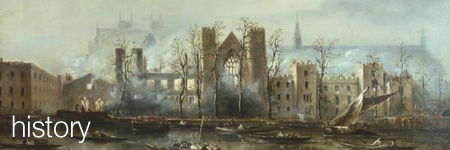
Westminster Abbey
(The Collegiate Church of St. Peter in Westminster) . Founded by Edward the Confessor. The main portion of the present Abbey (a name which originally meant a monastery ruled by an abbot) was built by Henry III, his work being carried on by Edward I, Richard II, Henry V, Henry VII, and numerous Abbots, the glorious dream-building being the work of many centuries. But the first church on this hallowed ground goes much further back than Henry III. According to the legends, on Thorneye (the Isle of Thorns) , where the Abbey stands, Sebert, King of the East Saxons (A.D. 606) , built a church at the instance of the first Bishop of London, Mellitus, a Roman, who had been consecrated by S. Augustine. However that may have been, it is certain that Edward the Confessor built a church there which was consecrated A.D. 1065 or 1066, and was succeeded by the Abbey much as we know it, which was opened A.D. 1269, or more than 650 years ago. Up to 1540 the Abbey was the church of a Benedictine monastery, its proper title being then Ecclesia Abbatiae Westmonasteriensis. The monastery was dissolved by Henry VIII in the year above mentioned. Much of the nave is the work of Edward the Confessor (1065) , this being incorporated in the glorious scheme of Henry III. It has been called the Valhalla of the English. Here lie Kings, Queens, and Princes, Bishops, Barons, and Knights, Warriors and Statesmen, Abbots and Priests, Poets, Authors, and Musicians, Divines and Philanthropists, Actors and Dramatists, and here the body of that "Unknown Warrior" of the greatest and most terrible of all wars. But merely Henry V, Henry VII, and numerous Abbots, the glorious dream-building being the work of many centuries. But the first church on this hallowed ground goes much further back than Henry III. According to the legends, on Thorneye (the Isle of Thorns) , where the Abbey stands, Sebert, King of the East Saxons (A.D. 606) , built a church at the instance of the first Bishop of London, Mellitus, a Roman, who had been consecrated by S. Augustine. However that may have been, it is certain that Edward the Confessor built a church there which was consecrated A.D. 1065 or 1066, and was succeeded by the Abbey much as we know it, which was opened A.D. 1269, or more than 650 years ago. Up to 1540 the Abbey was the church of a Benedictine monastery, its proper title being then Ecclesia Abbatiae Westmonasteriensis. The monastery was dissolved by Henry VIII in the year above mentioned. Much of the nave is the work of Edward the Confessor (1065) , this being incorporated in the glorious scheme of Henry III. It has been called the Valhalla of the English. Here lie Kings, Queens, and Princes, Bishops, Barons, and Knights, Warriors and Statesmen, Abbots and Priests, Poets, Authors, and Musicians, Divines and Philanthropists, Actors and Dramatists, and here the body of that "Unknown Warrior" of the greatest and most terrible of all wars. But merely to name those who rest or who are commemorated here would need many pages. Furthermore, such an attempt would be outside the scope of this little book.